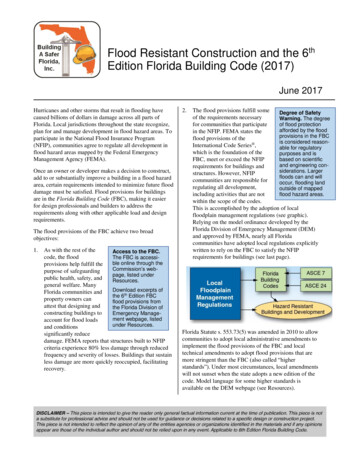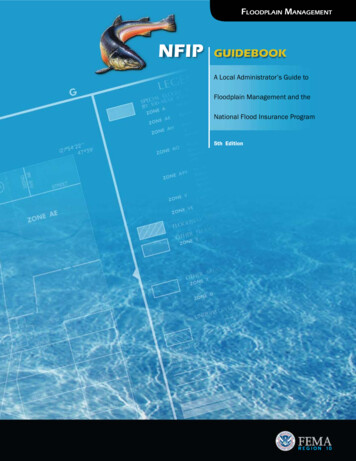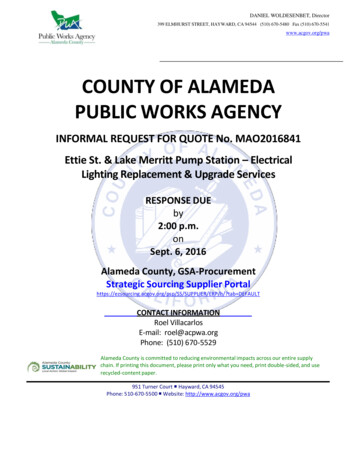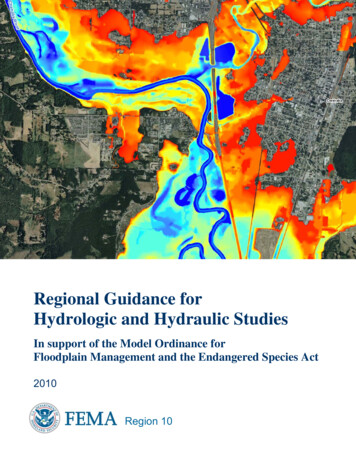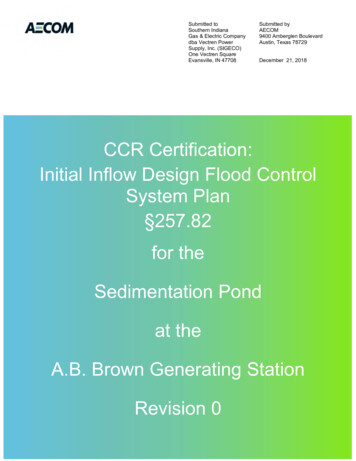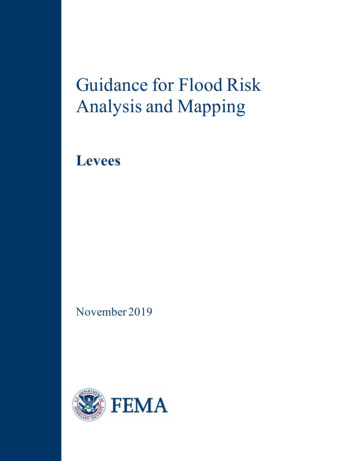
Transcription
Guidance for Flood RiskAnalysis and MappingLeveesNovember 2019
Requirements for the Federal Emergency Management Agency (FEMA) Risk Mapping,Assessment, and Planning (Risk MAP) Program are specified separately by statute, regulation,or FEMA policy (primarily the Standards for Flood Risk Analysis and Mapping). This documentprovides guidance to support the requirements and recommends approaches for effective andefficient implementation. The guidance, context, and other information in this document is notrequired unless it is codified separately in the aforementioned statute, regulation, or policy.Alternate approaches that comply with all requirements are acceptable.For more information, please visit the FEMA Guidelines and Standards for Flood Risk Analysisand Mapping webpage analysis-andmapping), which presents the policy, related guidance, technical references, and otherinformation about the guidelines and standards development process.LeveesGuidance Document 95November 2019Page i
Table of RevisionsThe following summary of changes details revisions to this document subsequent to its mostrecent version in February 2019.Affected Section orSubsectionDateSection 1 and allsubsectionsNovember2019Corrected minor typos and alignment of wording.Section 2November2019Corrected minor typos and alignment of wording.Removed list of acronyms.Section 3 and allsubsectionsNovember2019Corrected minor typos and alignment of wording.Section 4 and allsubsectionsNovember2019Corrected minor typos and alignment of wording.Section 5 and allsubsectionsNovember2019Corrected minor typos and alignment of wording.Section 6 and allsubsectionsNovember2019Corrected minor typos and alignment of wording.Section 7 and allsubsectionsNovember2019Corrected minor typos and alignment of wording.Section 8 and allsubsectionsNovember2019Corrected minor typos and alignment of wording.LeveesGuidance Document 95DescriptionNovember 2019Page ii
Table of Contents1.0Levees Overview . 11.1Prior Guidance Documents . 21.2Flood Hazard Mapping and Levees . 21.3Summary of Recent Legislation and Recommendations . 51.4Levee-Related Communication and Community Engagement . 61.5Chapter Overviews. 72.0Glossary . 93.0Levee Data Inventory . 163.1Background . 163.2National Levee Database. 173.3Identification and Mapping of Levees in Flood Hazard Studies and Map Revisions. 173.4FEMA Regulatory Levee Data . 193.5Tracking Levee Accreditation Status . 203.6Reporting Levee System Updates . 203.7Levee Data Storage Standards. 214.0Accredited Levee Systems . 224.144 CFR 65.10 Requirements . 244.2Additional Levee Accreditation Considerations . 374.3Levee Accreditation Reviews . 454.4Accredited Levee Mapping and Notes. 515.0Provisionally Accredited Levee Systems. 545.1Provisional Levee Accreditation Overview . 545.2PAL Eligibility Requirements . 555.3Considerations for Offering PAL to PAL Eligible Levee Systems . 565.4PAL Communication and Coordination Processes . 595.5PAL Mapping and Notes . 656.0Non-Accredited Levee Systems . 666.1Non-Accredited Levee Systems Defined . 666.2Other Considerations . 676.3Levee Analysis and Mapping Procedure . 686.4Levee Data Collection and Stakeholder Engagement (Figure 11, Element 200) . 71LeveesGuidance Document 95November 2019Page iii
6.5Local Levee Partnership Team (Figure 11, Element 300) . 796.6Local Levee Partnership Team Meetings (Figure 11, Element 300) . 816.7Levee Analysis and Mapping Plan (Figure 11, Element 400) . 836.8Additional Data Collection (Figure 11, Element 410) . 846.9System-Wide Analysis and Mapping Procedures (Figure 11, Element 610) . 856.10Interior Drainage Analysis . 856.11Levee Reach Analysis and Mapping Procedures (Figure 11, Element 620) . 876.12Natural Valley Procedure (Figure 11, Element 620) . 896.13Structural-Based Inundation Procedure (Figure 11, Element 620) . 936.14Overtopping Procedure (Figure 11, Element 620) . 996.15Freeboard Deficient Procedures (Figure 11, Element 620) . 1046.16Sound Reach Procedure (Figure 11, Element 620) . 1056.17Flood Hazards Evaluated by Flooding Source (Figure 11, Element 630) . 1076.18Hydrograph Development . 1076.19Regulatory Floodways. 1116.20Hydraulic Modeling on Landside of the Levee . 1226.21Flood Hazard Mapping . 1256.22Guidance Regarding Flood Insurance Study Report Standards. 1306.23Documentation . 1316.24Review Procedures . 1317.0Non-Levee Reaches and Non-Levee Features. 1327.1Non-Levee Reach . 1337.2Non-Levee Features . 1347.3Communication of Risk . 1358.08.1FEMA and Other Federal Agency Coordination. 136USACE . 136List of FiguresFigure 1: Example Levee System A . 23Figure 2: Freeboard Determination . 26Figure 3: Freeboard Near Structures . 26Figure 4: Wave Runup . 29LeveesGuidance Document 95November 2019Page iv
Figure 5: Levee System Designed to End in the Absence of High Ground. 38Figure 6: Levee System Tying into Non-Levee Reach . 39Figure 7: Non-Accredited Levee System. 39Figure 8: Multiple-Levee Scenario . 53Figure 9: PAL Determination Decisions Tree . 59Figure 10: Initial Notification Letter within Risk MAP Project Timeline . 62Figure 11: FEMA Levee Analysis and Mapping Procedure . 70Figure 12: Levee Data Collection and Stakeholder Engagement Process . 72Figure 13: Sample of Potential Inundation Extents . 79Figure 14: Example Segmentation of a Levee System . 88Figure 15: Natural Valley Cross-Section View . 91Figure 16: SFHA Delineation Using Natural Valley Procedure. 92Figure 17: Structural-Based Inundation Cross-Section View. 97Figure 18: SFHA Delineation Using Structural-Based Inundation Procedure . 98Figure 19: Overtopping Cross-Section View . 102Figure 20: SFHA Delineation Using Overtopping Procedure. 103Figure 21: Freeboard Deficient Cross-Section View . 105Figure 22: Sound Reach Cross-Section View . 106Figure 23: Sample Dimensionless Unit Hydrograph . 109Figure 24: Floodway Analysis Process Initial Analysis . 115Figure 25: Floodway Analysis Process Initial Analysis . 115Figure 26: Final Regulatory Floodway. 116Figure 27: Both Encroachments (A and B) on Riverside of Levees . 117Figure 28: One Encroachment on Riverside of Levee (A) and the Other on Landside of Levee(B). 117Figure 29: The Landside Encroachment (B) Moved to the Levee . 117Figure 30: Both Encroachments at Levees . 118Figure 31: Both Encroachments Landward of the Levees . 118Figure 32: Use of Natural Valley Procedure to Determine Initial Encroachment Stations A and B. 119Figure 33: Using Left levee holding to find encroachment station C . 120Figure 34: Right Levee Holding to Find Encroachment Station D . 120Figure 35: Both levees Are Non-accredited . 121LeveesGuidance Document 95November 2019Page v
Figure 36: Left Levee Is Non-accredited, Right Levee Is Accredited . 121Figure 37: Right Levee Is Non-accredited, Left levee Is Accredited. 121Figure 38: Composite Mapping of Flood Hazards for the Levee System . 127Figure 39: Non-Levee Reach. 134Figure 40: Non-Levee Feature . 135List of TablesTable 1: Levee Terms . 9Table 2: Summary of Minimum PAL Requirements . 55Table 3: Suggested Timeline for Additional Data. 85Table 4: Summary of Stakeholder Data Requirements for Reach Analysis Procedures . 89Table 5: Sample Summary of Hydrologic and Hydraulic Analyses Table Guidance ClarificationRouting . 130Table 6: Crop Insurance, Flood Insurance Rate Maps, and Levees . 138LeveesGuidance Document 95November 2019Page vi
1.0Levees OverviewThis consolidated guidance document was prepared for FEMA, as part of the Risk MAP program,to promote sound and consistent implementation of levee-related National Flood InsuranceProgram (NFIP) regulations and mapping program standards that apply to levees.This guidance document is intended to provide current information on the mapping of levees andassociated flood hazards. This document captures current standards and practices and,therefore, does not address all topics related to the identification of flood hazards and risksassociated with levees.Federal, State, and local officials have often considered levee systems an effective structuralapproach for reducing average annual flood losses. However, it is an approach that needs to beconsidered cautiously. Carefully engineered and well-maintained levees should divert floodflowsas intended in their design and keep the areas landward of the levees dry if their structural integrityis not compromised, all elements of the system are functional, and the floodwaters do not overtopthe structure. However, a primary drawback is that levees could lead to increased developmentof areas landward of the levees over time and thereby increase the exposure to catastrophicfailures during extreme events (A Levee Policy for the National Flood Insurance Program,National Academy Press, 1982).When it comes to working with communities on levee-related mapping projects or issues, FEMAshares a mission with its State agency partners, the U.S. Army Corps of Engineers (USACE), andother Federal agencies. That mission entails helping levee owners, flood control districts,community officials, floodplain managers, the media, and other stakeholders understand andproperly communicate the risks associated with living and working landward of levees. Living withlevees is a shared responsibility and local community officials should remain engaged in floodrisk management activities. It is important for all stakeholders to know the risk; their role in helpingto reduce that risk; and what specific actions they can take, including the purchase of floodinsurance to further reduce the financial risk associated with living and working in levee-impactedareas. For more information, visit the Living with Levees: It’s a Shared Responsibility portion ofthe FEMA website ity).The primary audiences for this guidance document are communities, regional entities, Tribalentities, and State agencies, including those participating in the Cooperating Technical Partnersprogram (CTPs), FEMA Project Teams that are formed to carry out projects in support of theFEMA Regional Offices, and FEMA Regional Office and Headquarters staff. The FEMA ProjectTeams often include representatives of the FEMA Risk MAP providers. This guidance documentis also intended for communities and local stakeholders involved in levee accreditation and theimplementation of FEMA non-accredited levee analysis and mapping procedures.The levee guidance in this document emphasizes the Risk MAP program vision of collaboratingwith local, regional, State, and Tribal entities throughout a watershed to deliver quality data thatincreases public awareness and leads to mitigation actions that reduce flood risk to life andproperty. To achieve this vision, FEMA transformed its historic documents for flood hazardLeveesGuidance Document 95November 2019Page 1
identification and mapping efforts into a more integrated process of identifying, assessing,communicating, planning, and mitigating flood-related risks aligned with the Risk MAP vision 1.To accomplish this process, the appropriate analyses, mapping, and communication of risk oflevee systems is necessary throughout the Risk MAP project lifecycle. FEMA has prepared thisconsolidated guidance in keeping with that responsibility.1.1Prior Guidance DocumentsThe consolidation of work that guided users through decades of levee-related proceduresimplemented during flood hazard mapping projects were incorporated into this guidancedocument. This is intended to promote sound and consistent implementation of policies,regulations, and standards for levee risk evaluation. This guidance enhances compliance with theCode of Federal Regulations; incorporates portions of Analysis and Mapping Procedures for NonAccredited Levee Systems New Approach, (July 2013); and FEMA standards to facilitateimplementation during flood hazard mapping projects. This guidance document has beenprepared to expand on, and supersede, guidance provided in FEMA Operating Guidance (OG)12-13; Procedure Memorandum (PM) Nos. 34, 43, 45, 51, 52, 53, and 63; and Appendix H ofGuidelines and Specifications for Flood Hazard Mapping Partners. More details for eachsuperseded guidance document are provided in each chapter of this document.This guidance document does not supersede the following existing FEMA guidance documents: Analysis and Mapping Procedures for Non-Accredited Levee Systems New Approach,dated July 2013. Guidance Document No. 29, Guidance for Flood Risk Analysis and Mapping: LeveeSeclusion, dated November 2014. Guidance Document No. 34, Guidance for Flood Risk Analysis and Mapping: Zone A99and Zone AR Determinations, dated May 2015. Guidance Document No. 72, Guidance for Flood Risk Analysis and Mapping: LeveeSpecific Non-Regulatory Flood Risk Datasets, dated May 2016.These and additional mapping guidance and best practices can be accessed through the FEMAGuidelines and Standards for Flood Risk Analysis and Mapping webpage.1.2Flood Hazard Mapping and LeveesFEMA does not design, build, inspect, operate, maintain, or certify levees. However, asadministrator of the NFIP, FEMA is responsible for accurately identifying flood hazards andcommunicating those hazards and risks to affected stakeholders.Conditions in a community or watershed change over time; therefore, the need to update floodhazard information reflected on Flood Insurance Rate Maps (FIRMs) is assessed periodically tobetter reflect the current flood risk to people and property. FEMA updates FIRMs nationwidethrough the Risk MAP program. FEMA shows levee systems on the FIRM as being accredited,1For more information on the Risk MAP program, see lanning-risk-map.LeveesGuidance Document 95November 2019Page 2
provisionally accredited, non-accredited, or in the process of being restored or constructed. FEMAdesignates the areas landward of the levees as Zone A, Zone AE, Zone AR, Zone A99, Zone D,Zone X (shaded), or Zone X depending on the status of the levee systems and the type of studyperformed. With new or updated FIRMs, community officials will have information to help themadvise where and how to build more safely, and the public will understand their risk, allowing moreinformed decisions about reducing the risk to families, homes, and businesses.Levees add complexity to an ongoing flood hazard study. To address the complexities that leveesintroduce, a FEMA Project Team should consider the presence of levees and appropriatemapping procedures as early in the study process as possible. Early consideration will helpensure that appropriate data collection and coordination occur. Subsections 1.2.1 through 1.2 5briefly introduce the possible mapping options for levees.1.2.1Accredited Levee SystemAn accredited levee system is a system that FEMA has determined meets requirements of theNFIP regulations as cited in the Code of Federal Regulations (CFR) at Title 44, Chapter 1, Section65.10 (44 CFR 65.10) and that FEMA has recognized on a FIRM as reducing the flood hazardsposed by a base (1-percent-annual-chance) flood. This determination is based on a submittal, byor on behalf of a community, which includes 44 CFR 65.10–compliant design data anddocumentation, certified by a registered Professional Engineer (P.E.), and operations andmaintenance documentation under the appropriate jurisdiction. FEMA strongly encourages floodinsurance for all insurable structures in floodplains, including those in areas landward of levees.FEMA accreditation of a levee system does not guarantee that the levee will provide flood hazardreduction to properties from flooding; therefore, FEMA has included a note on related FIRMpanels that overtopping, or failure of an accredited levee system is possible. To mitigate flood riskin residual risk areas, property owners and residents are encouraged to consider flood insuranceand floodproofing or other protective measures. Chapter 4 of this document provides detailedinformation on the mapping of accredited levee systems.1.2.2Provisionally Accredited Levee SystemWhen the area impacted by an accredited levee system shown on an effective FIRM is in theprocess of being remapped, FEMA may ask the levee owner or community to provide data anddocumentation demonstrating the levee system still meets the requirements set forth in 44 CFR65.10. To assist levee owners and communities, FEMA established the Provisionally AccreditedLevee (PAL) designation as an option for mapping the area while providing levee owners orcommunities more time to gather the required data and documentation. The levee owner signsand submits an agreement to FEMA indicating the data and documentation required forcompliance with 44 CFR 65.10 will be provided within 24 months of the 91st day following thedate of the initial FEMA notification letter. FEMA places a note on the impacted FIRM panel(s)landward of the levee system to indicate FEMA has provisionally accredited the levee system andthe designation of any existing Zone X (shaded) areas of flood hazard reduction due to levees isprovisional. Chapter 5 of this document provides detailed information on the mapping of PALs.LeveesGuidance Document 95November 2019Page 3
1.2.3Non-Accredited Levee SystemNon-accredited levee systems are levee systems that do not meet the NFIP regulatoryrequirements of 44 CFR 65.10 and that are not shown on a FIRM as reducing the base floodhazard. FEMA recognizes that non-accredited levee systems do impact flood risk; for that reason,FEMA has developed analysis and mapping procedures for non-accredited levees that provide asuite of approaches for analyzing flood hazards landward of levee systems. Chapter 6 of thisdocument provides detailed information on the mapping of non-accredited levee systems.1.2.4Levees Undergoing Restoration (Zone AR) and Undergoing Construction (ZoneA99)The NFIP regulations contain two provisions that help ameliorate the flood insurance impact onproperty owners during the restoration of non-accredited levee systems or construction of newlevee systems. These are based on provisions of the National Flood Insurance Act of 1968, asamended, as cited in the United States Code (U.S.C.) at 42 U.S.C. 4014 (e) and 42 U.S.C.4014(f). These provisions are intended to provide reduced flood insurance premium rates forinsurable structures landward of levee system projects designed and intended for eventualaccreditation. Under these provisions, a levee system undergoing construction, or restoration, butthat cannot currently meet 44 CFR 65.10 requirements, is recognized by FEMA as providing some(less than the base flood) level of hazard reduction.FEMA issues Flood Protection Restoration determinations, regulated through 44 CFR 65.14, inareas where a project is sufficiently underway to restore a levee system to meet 44 CFR 65.10accreditation requirements. FEMA maps the areas landward of the levee system that is beingrestored as Zone AR on the FIRM and may present Base Flood Elevations (BFEs) representingthe current hazard as if the levee system was not in place. The Zone AR determination mayprovide property owners with reduced flood insurance premium rates lower than rates in othermapped Special Flood Hazard Areas (SFHAs).FEMA issues adequate progress determinations, regulated through 44 CFR 61.12, in areas whereFEMA determines that a community has made adequate progress on a levee system constructionor reconstruction project designed for flood hazard reduction. FEMA maps the areas landward ofthe levee system as SFHAs designated Zone A99 on the FIRM. The Zone A99 determination alsoprovides flood insurance premium rates and floodplain management requirements that aregenerally less than those required in other SFHAs. The Zone A99 designation is used in place ofa shaded Zone X protected by levee designation for the landward area of the levee system. Thehorizontal extent of the Zone A99 would match the boundary extent of the potential area ofreduced flood hazard that in the future would be adjusted to a shaded Zone X protected by leveedesignation.Detailed information on Flood Protection Restoration and Adequate Progress determinations isprovided in FEMA Guidance Document No. 34, Guidance for Flood Risk Analysis and Mapping:Zone A99 and Zone AR Determinations. Guidance Document No. 34 is accessible through theFEMA Guidelines and Standards for Flood Risk Analysis and Mapping webpage.LeveesGuidance Document 95November 2019Page 4
1.2.5Levee Seclusion MappingIn March 2011, FEMA committed to updating the way flood hazards for non-accredited leveesystems were analyzed and mapped. As a result, some in-progress FIRM updates that includedlevee systems were delayed or otherwise impacted while FEMA developed the analysis andmapping approach for non-accredited levees. FEMA developed the levee seclusion mappingapproach as a project management solution to allow the release of the FIRM updates for thoseportions of the community outside of the levee-impacted area. Through the levee seclusionmapping approach, FEMA maintains the flood hazard information as depicted on the currenteffective FIRM (the FIRM in effect before the in-progress update) with map notes explaining thatthe flood hazard information in these areas will be updated after FEMA applies an updated leveeanalysis and mapping approach. Levee seclusion was not intended to be a long-term mappingapproach and was not anticipated to be implemented on any mapping projects initiated after July2013. Detailed information on seclusion is provided in FEMA Guidance Document No. 29,Guidance for Flood Risk Analysis and Mapping: Levee Seclusion, which is accessible through theFEMA Guidelines and Standards for Flood Risk Analysis and Mapping webpage.1.3Summary of Recent Legislation and RecommendationsThis section summarizes some recent legislation and recommendations related to managing andassessing levee systems.1.3.1Water Resources Development Act of 2007Title IX of the Water Resources Development Act (WRDA) 2007, the National Levee Safety Actof 2007, as amended, includes activities incentivizing the creation of State and Tribal levee safetyprograms and increased public awareness of levee systems. Activities include, among other provisions,the development and maintenance of the National Levee Database (NLD); inventory and review levees;development of levee guidelines; and development of technical assistance and training materials.Recommendations leading up to this legislation can be found on the USACE .1.3.2Flood Protection Structure Accreditation Task ForceThe USACE and FEMA formed the Flood Protection Structure Accreditation Task Force (TaskForce) in accordance with Section 100226 of Public Law (
For more information, please visit the FEMA Guidelines and Standards for Flood Risk Analysis and Mapping webpage

